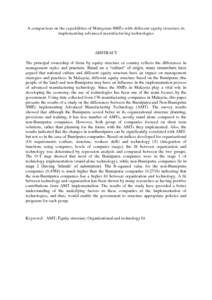Citation
Mohd Yusuff, Rosnah and Saberi, Sara and Zulkifli, Norzima
(2009)
A comparison on the capabilities of Malaysian SMEs with different equity structure in implementing advanced manufacturing technologies.
Asian International Journal of Science and Technology in Production and Manufacturing Engineering, 2 (1).
pp. 61-73.
ISSN 1906-151X
Abstract
The principal ownership of firms by equity structure or country reflects the differences in management styles
and practices. Based on a “culture” of origin, many researchers have argued that national culture and
different equity structure have an impact on management strategies and practices. In Malaysia, different
equity structure based on the Bumiputra (the people of the land) and non-Bumiputra may have an influence in
the implementation process of advanced manufacturing technology. Since the SMEs in Malaysia play a vital
role in developing the economy, the use of technologies has been one of the main focuses by the government.
Using data collected from 136 manufacturing companies in Malaysia, this paper presents the results of a study
on the differences between the Bumiputra and Non-Bumiputra SMEs implementing Advanced Manufacturing
Technology (AMT). The survey results showed that although the Bumiputra scored better in its organizational
structure planning, provisions and training, it has less number of AMTs, mostly stand alone compared to the
non-Bumiputra companies. However, both group of companies focused on short term solutions, rather than
planning for the future with the AMTs they implemented. Also, the results indicated that the changes in nonBumiputra
can be significantly correlated with AMT, but not so in the case of Bumiputra companies. Based on
indices developed for organizational (O) requirements (culture, structure, workers skill) and technology (T)
(integration of functions using computer, levels of computer usage), the fit between organization and
technology was determined by regression analysis and compared between the two groups. The O-T map
showed that most of the Bumiputra companies were in the stage 1 of technology implementation (stand-alone
technology), while non-Bumiputra companies lie in stage 2 (having ‘Islands’ of automation). The R-squared
value for the non-Bumiputra companies (0.4584) is much higher than the Bumiputra companies (0.2516)
indicating that the non-Bumiputra companies has a higher fit between organization and technology. A fit
between technology and organization has been shown by many researches as having positive contributions
from AMT implementation. The results of the study have provided a better understanding of the underlying
factors in these companies in the implementation of technologies, and thus, would enable the government to
structure appropriate policies and programs for each group.
Download File
![[img]](http://psasir.upm.edu.my/12674/1.hassmallThumbnailVersion/A%20comparison%20on%20the%20capabilities%20of%20Malaysian%20SMEs%20with%20different%20equity%20structure%20in%20implementing%20advanced%20manufacturing%20technologies.pdf)  Preview |
|
PDF (Abstract)
A comparison on the capabilities of Malaysian SMEs with different equity structure in implementing advanced manufacturing technologies.pdf
Download (184kB)
| Preview
|
|
Additional Metadata
Actions (login required)
 |
View Item |

